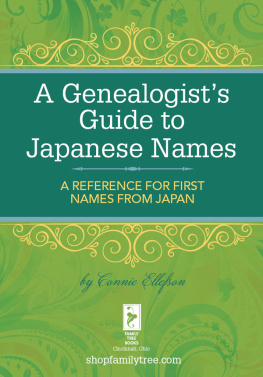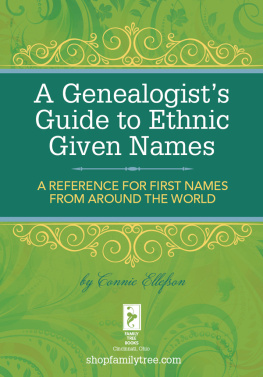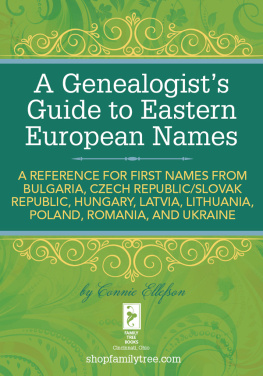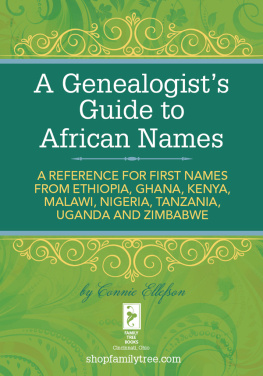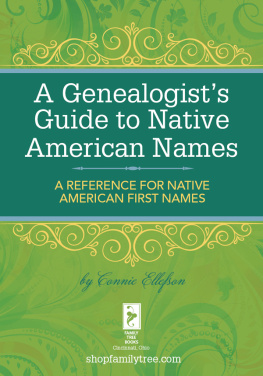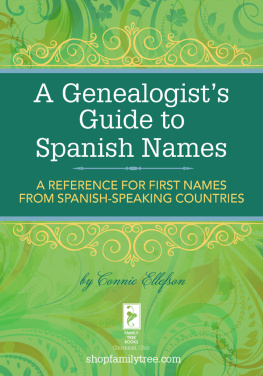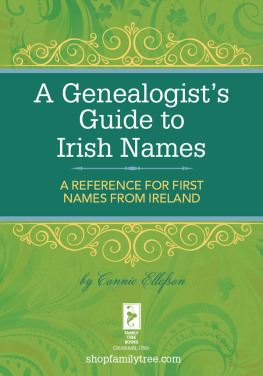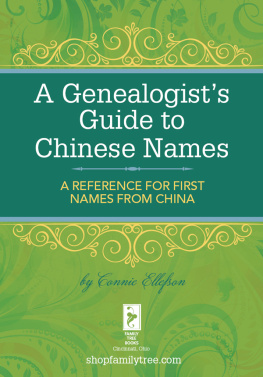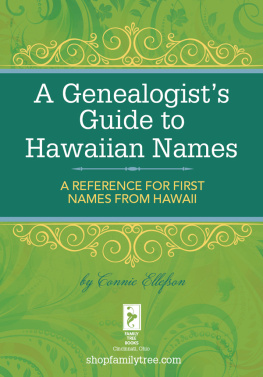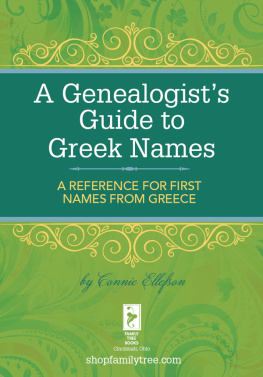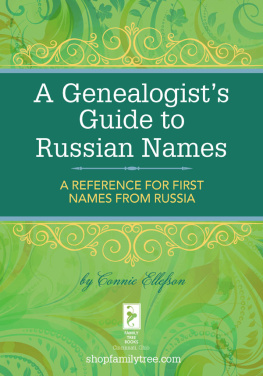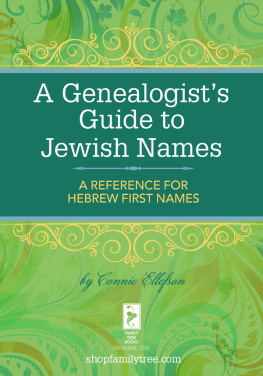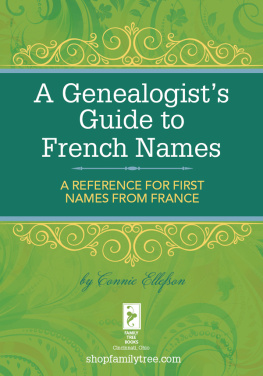A Genealogists Guide to Japanese NamesA REFERENCE FOR FIRST NAMES FROM JAPANby Connie Ellefson Cincinnati, Ohio shopfamilytree.com
Japan
Japan had been isolated for hundreds of years when Commodore Matthew Perry of the U.S. navy convinced Japan to open its ports to the West in 1869. Not surprisingly, there is no recorded immigration from Japan until 1861, and even then, less than 300 Japanese arrived between 1861 and 1880. Most of them came by accident as shipwrecked sailors. In 1885, the Japanese government passed laws allowing people to emigrate. After that, immigration from Japan rose sharply, fueled by the Chinese Exclusion Act of 1882, which prohibited Chinese immigration.
A severe labor shortage on the West Coast led to an influx of Japanese, most of whom were willing to work for low wages. Japanese immigration was also encouraged by a law passed by the Japanese government in 1896 allowing a person to emigrate only if he had someone responsible for his financial support should he become ill or unable to work. Because the financial requirements were so strict, few Japanese families could afford an emigrant. However, emigration companies arose in Japan in cooperation with American companies that provided the necessary financial backing in exchange for a work contract. This system proved enormously successful, and between 1899 and 1904, nearly 60,000 Japanese came to America this way, primarily ending up in California and the territory of Hawaii. The total immigration between 1891 and 1924 was recorded at nearly 300,000; however, many returned to Japan or went back and forth several times.
By 1920, about 110,000 Japanese lived in California and an equal number in Hawaii. West Coast natives began to fear that the Japanese would flood the labor market in a rerun of the earlier panic that led to the Chinese Exclusion Act of 1882. Under pressure from the public, the U.S. negotiated the Gentlemens Agreement with Japan under which Japan agreed to voluntarily restrict emigration of laborers. Professionals could still immigrate, however, so arrivals continued. Also picture brides, courted by the families of Japanese immigrants, came to relieve the two-to-one balance of male to female among the immigrants.
Japanese immigration virtually came to a halt in 1924, when the Immigration Act excluded immigrants who could never become citizens. At the time, only whites and Negroes could become naturalized citizens. After World War II, Japanese brides of American soldiers stationed in Japan (an estimated 25,000 by 1960) began to arrive along with other non-quota immigrants. In the 1960s and 1970s, the immigration from Japan was about 4,000 per year. Because of their low numbers, these new immigrants were able to assimilate fairly easily into mainstream culture.
Naming Traditions
Japanese names come from a variety of sources.
Some names are made up when parents take a Chinese character and interpret it in some unique way. They may play with syllables to come up with a new name, but this is more common for girls than boys. Boys and girls may be named for someone in the family or country who has achieved much. Male virtues such as courage, wisdom, power and tranquility may be a name source. The female virtues embodied in names are such attributes as gentleness, wisdom, purity and beauty. Number names are sometimes used.
Low numbers denote birth order, and very high numbers such as chi (thousand) represent a wish for the childs long life. Girls may be named for the flower of the month they were born in; for instance, kiku means chrysanthemum and is the month flower for November. Foreign names used as Japanese names are possible if they sound Japanese. Mari (Mary) and Mai (May) are popular now, by coincidence, and each means something in Japanese. The suffixes -ko, -e and -yo denote female names, and the suffix -o appears in male names.
Pronunciation
Japanese pronunciation is very consistent.
Vowels and consonants are the same as in English.
Japanese Female Names
Ai (ah-EE) love, indigo blue
Aiko little love, beloved
Akako red
Akasuki bright helper
Aki (ah-KEE) born in autumn
Akina very bright spring flower, bright leaves
Anzu apricot
Aoi hollyhock
Asa (AH-sah) born in the morning Au meeting
Ayako damask pattern
Ayam iris flower
Azami thistle flower
Chika near, Chikako Chikako clever, wisdom
Chitose thousand years
Chiyo thousand generations
Chizu a thousand storks; Chizuko
Cho born at dawn, butterfly
Dai great
Den bequest from ancestors
Etsu delight
Fuyu born in winter
Gen source, spring
Gin silver; Gina
Hama (hah-MAH) shore; Hamako
Hanako flower, fair blossom; Hana, Hanae
Haru born in spring
Haru springtime bay
Haruko tranquil, born in spring
Hatsu firstborn
Haya quick, light
Hid excellent
Hidyo superior generations
Hiro broad
Hiroko magnanimous
Hisa (hee-SAH) long lasting; Hisako, Hisae, Hisayo
Hisano long plain
Hoshi star; Hoshiko, Hoshie
Iku nourishing
Ima now; Imako
In rice
Isamu vigorous, robust
Ishi (ee-SHEE) stone; Ishie
Ito thread
Iwa rock
Jin tenderness
Junko obedient
Kaed maple leaf
Kagami mirror
Kaiyo forgiveness
Kama sickle
Kame tortoise (symbol of long life)
Kameko tortoise child (hope for long life)
Kameyo generations of the tortoises
Kana a character of the alphabet
Kane (KAH-nee) the doubly accomplished; Kaneko
Kaoru fragrant
Kata worthy
Katsu victorious
Kawa river
Kaya a yew, a rush
Kazashi hair ornament
Kazu first, obedient; Kazuko
Kei rapture, reverence; Keiko
Kichi fortunate; Yoshi
Kiku chrysanthemum branch
Kikuko chrysanthemum (flower for November)
Kikuno chrysanthemum field
Kimi peerless; Kimiko, Kimiyo, Kimie
Kin gold
Kinu silk cloth
Kishi beach
Kiwa born on a border; Kiwako
Kiyo happy generations, pure
Kiyoshi clear, bright
Ko filial piety
Kohana little flower
Koko stork
Koma filly, term of endearment; Komako
Kom rice
Konomi nuts
Koto harp
Kozakura little cherry tree
Kozue branches of a tree
Kukiko snow
Kuma bear
Kumi braid; Kumiko
Kuni 
